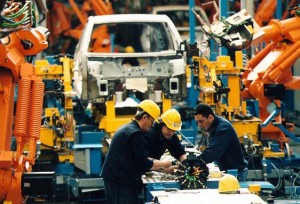Mon 3 Oct 2011
Besides the last two years, now, the annual Mexican migration into America has been increasingly larger. Legal migration or not, the hope of the “American Dream” still lies in the hearts and minds of thousands of Mexicans as they make a treacherous journey into America. As data shows, from the article “A Right to Move-and to Stay Home”, by Joseph Nevins, the number of migrants dropped from over 500,000 in 2004, to just around 100,000 this year. (https://nacla.org/blog/2011/7/13/right-move—and-stay-home)The large drop-off is a direct result of the Clinton, Bush, and Obama efforts to put a stop to the illegal migration, but another underlying and even more substantial factor is the economic boom Mexico is experiencing. Now, one might wonder what is powering and heightening the Mexican economy?

The American and European economies are facing enormous deficits, while a surprising Mexico is powerfully boosting ahead economically. According to “Latam economies race ahead”, by Simon Romero, the Mexican government claims that they are out outpacing America. Over the first quarter, the Mexican economy has already grown 4.3% and expecting to rise to 5% by the end of the year, while the U.S is projected to only grow .2% in the next year. Mexico’s growth is driven mainly by manufacturing and assembly line type of employment. As Randall C. Archibold explains in the article “Despite Violence, US Firms Grow in Mexico”, “TV sets are being assembled, car parts boxed up and electronic widgets soldered together in the large manufacturing plants here known as maquiladoras. The result is a boomlet in jobs in some of Mexico’s hardest-hit cities.” Jobs in the manufacturing field grew 8.2%, amounting to over 1.8 million workers. As a result of this burst of industrial business, Mexico decreased their unemployment and they are keeping inflation to a minimum. Manufacturing is fueling the economic growth, which in return has increase the middle class of Mexicans.(https://nacla.org/blog/2011/7/19/mexican-economy-booming)

Mexico has generally been split between the “rich” and the “poor” with an almost non-existent middle class. However, with the recent economic growth, the middle class of Mexico has also enlarged. The increase in the middle class is another factor that is leading to the success of the economy. With a larger middle class, more hard-earned money is circulated throughout Mexico’s own businesses. For instance, the sale of domestic goods, whether it’s buying food from a local restaurant or buying typical suburban style cloths, has risen. The larger middle class is substantial for a steady exchange of goods and services, which keeps money flow within their economy. A more sustained middle class has proven to sustain the Mexican economy, while raising their gross domestic production of goods and services.(http://www.latinamericanpost.com/index.php?mod=seccion&secc=2&conn=6210)

In conclusion, the strides Mexico has made industrially have stimulated their economy encouragingly in the past year. Compared to the usual economic powers, such as the U.S. and Britain, Mexico has had a larger growth rate than both. As a result, the Mexican middle class has also expanded and therefore shortening the large gap between the rich and poor. At the same time, the middle class’s higher incomes infuse more money back into the economy, increasing their national GDP.



